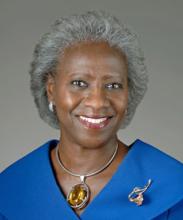
August 2018
DR. VALANTINE'S FOOD FOR THOUGHT

Hannah A. Valantine, MD
Chief Officer for Scientific Workforce Diversity
What do you think of when you hear "diversity?" In this issue, read about how individuals and institutions striving to capture innovation and creativity consider various diversity characteristics, including socioeconomic status and disability. Also check out recent trends in diversity of the NIH-funded workforce—as well as tools to enhance inclusive excellence at NIH and in academia.
Lost Einsteins: Who Becomes an Inventor in America?
Among the many characteristics that contribute to workforce diversity, socioeconomic status is an important influence on an individual’s access to resources. This is currently being addressed by the NIH-funded BUILD program that provides financial support to undergraduate students who would not otherwise be able to afford higher education. A recent analysis shows that individuals from low-income families are also far less likely to become inventors. These so-called "lost Einsteins" may have had high-impact inventions had they become inventors. Read about who is most likely to become an inventor and some creative strategies to help diversify the STEM talent pool.
What's in a Name?
"Darwin is the father of evolution." Louis Pasteur had a whole process named after him. Yet, "Mother Theresa devoted her life to the poor" and "Princess Diana was beloved by many." Research shows that we tend to refer to famous men, but not women, by their last names, and that it may affect our view of them. Gender bias—considering women and men by different standards—plays out in a number of ways. In one study, for example, women introduced by men at medical lectures were less likely to be addressed by their professional title than were men introduced by men , which may contribute to career-affecting stereotypes.
What Does it Take to Make an Institution More Diverse?
"It takes more than a vow," says a recent set of interviews from institutional leaders. In a recent Nature feature story, six researchers share their successful strategies. They aren’t all that difficult, but require intentionality and leadership support. They include establishing objective criteria for hiring and promotion, using data to back up decision-making, promoting sponsorship for faculty from underrepresented groups, and thinking outside of the box to attract people with different abilities, such as deaf scientists.
Open Mike: Trends in Diversity Within the NIH-funded Workforce
In 2017, NIH launched the Next Generation Researchers Initiative, which is a multi-pronged approach to increase the number of NIH-funded early stage investigators. An important component of this initiative is the call for increased transparency and availability of data about the make-up of the biomedical research workforce. Check out a recent Open Mike blog post in which Dr. Mike Lauer, director of the NIH Office of Extramural Research, cites a new NIH studythat looked at trends in workforce diversity among NIH-funded scientists over time.
Association of American Medical Colleges Hosts Webinar on NIH Scientific Workforce Diversity Toolkit
Recently, on July 30, 2018, the NIH Scientific Workforce Diversity office partnered with the Association of American Medical Colleges (AAMC) to host a webinar about the NIH Scientific Workforce Diversity Toolkit, a free, downloadable interactive resource to help institutions diversify their faculty. Watch to learn about evidence-based interrelated activities that SWD is currently using to foster an inclusive culture that unleashes the power of diversity to achieve research and institutional excellence.

The links above are pulled from the top news articles trending on the subject of diversity in science and technology.
The stories selected are not a reflection of the views of the National Institutes of Health.

